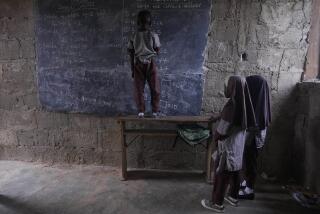African Engineering School’s Light Dims : Education: World Bank calls the program a success. Goal of the facility was to help country’s utilities work together and link up in power grids.
- Share via
BINGERVILLE, Ivory Coast — Black Africa’s only international school for electrical engineers is turning out 20 a year and the World Bank calls it “an undoubted success.”
The engineers would seem essential to development on a continent where insufficient, unreliable electric power hinders industrial expansion. But the school, whose facilities include the latest electronic gear and a high-tension laboratory, may be forced to close.
Africa is in economic decline and the national utilities that own the college have been forced to reduce the number of students they send to it. That raises the cost of operation and causes further reductions in enrollment.
A World Bank report said the Interafrican Electrical Engineering College is “an undoubted success in that it produces a high-quality, immediately useful graduate.”
It nestles among groves of oil palms in Bingerville, the old colonial capital of this former French possession. The school was designed for 250 students, but now has only 103.
The electric utilities of 20 member countries founded the college in 1979. The government provided land next to its national training facility for electricians in Bingerville, six miles east of Abidjan, the modern capital.
Issiaka B. Ly, a Malian who has been at the school since it opened, recalled: “I was regularly visited by snakes in the dormitory. I had a whole floor to myself.”
Ly, in charge of language studies, said one goal of the school was to help African utilities work together and eventually link up in power grids. Language instruction is a priority so graduates will be bilingual in French and English, the two main international languages spoken in member countries.
Students begin the five-year program with seven hours of study a day in either French or English for five weeks.
Students follow the traditional curriculum of subjects pursued by electrical engineers in the developed world, but also must study management, including how to run a business.
A chief weakness of African utilities has been their failure to collect bills and control expenses.
Bingerville students also have to dig ditches and climb utility poles. They spend summers working for member utilities.
After graduating, an engineer must spend 10 years with the sponsoring national utility.
Nathalie Kouassie, 22, of Adzope, Ivory Coast, said: “It is our duty to work for our country because they paid for our education,”
Fellow fifth-year student Alain Kouma, 25, of Franceville, Gabon, said manual labor is a useful part of the training because “it is necessary to know the difficulties people face. We must be able to do it.”
Cooperative programs with universities and electrical utilities in Europe assure that the university’s graduates meet international standards.
Even with the school established, however, member utilities that own it often prefer to send students overseas, said Francois Acho Achiepi, the college’s director.
“African leaders are used to sending students overseas,” he said. “It’s almost psychological.”
Achiepi conceded that it costs up to 25% more to send a student to his school, but added: “We pay everything here, from medical care to clothes to pocket money. All the student has to do is go to class.”
Colleges in developed countries do not pay those costs, and he said the Bingerville school is competitive if they are counted.
Emergency aid from foreign donors helped the school get through last year, but more help will be needed in 1991. Two-thirds of the operating budget comes from the utilities that own it.
Declining enrollments have meant less aid from the owners, and the World Bank report says the school responded by cutting costs.
Basic facilities must be maintained, including an adequate teaching staff, whatever the number of students, but only greater enrollment can reduce the cost per student.
More to Read
Sign up for Essential California
The most important California stories and recommendations in your inbox every morning.
You may occasionally receive promotional content from the Los Angeles Times.












